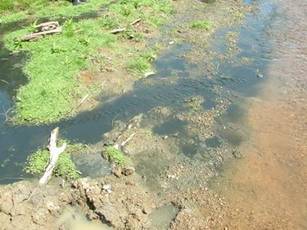Introduction
Within this section…
There are approximately 1,050 dairy farms in Northland. Collectively they produce over 11 million litres of farm dairy effluent (FDE) per day. This effluent can be applied to land or it must be adequately treated before disposal to water. For more information about different treatment/disposal systems refer to pages 6 and 7.
The discharge of FDE to water can have the following effects on receiving waters:
· Increased nutrient loadings (especially nitrogen and phosphorous), which can result in algal blooms.
· Increased ammonium concentrations, which can be toxic to fish species.
· Microbial contamination rendering the water unsuitable for stock drinking or contact recreation.
· Increased suspended solids, which reduces light penetration and can smother benthic (bottom-dwelling) invertebrates.
· Decreased oxygen concentration, which is required by aquatic organisms for respiration.
What are the Rules?
The rules that apply to Farm Dairy Effluent are set out in Section 16 ‘Rules for Animal Effluent Discharges' of the Regional Water and Soil Plan for Northland (refer to NRC website).
The disposal of untreated or treated effluent to land is a "permitted activity" provided that there is:
· No effluent discharged to water;
· No effluent is applied within 20m of water;
· No overland flow of sludge;
· No effluent runoff to water;
· No contamination of ground water;
· No effluent discharge within 20m of the property boundary; and
· Contingency measures in place to ensure that there is no discharge to water due to equipment failure, overflow of effluent, or prolonged wet weather.
All the farms that meet the above permitted activity rule are monitored annually as non-consented farms (refer page 5).

The photo above shows discolouration in a stream caused by a FDE discharge.
The disposal of treated effluent to water is a "discretionary activity", meaning that Resource Consent is required to authorise the discharge. The consent holder is required to abide by the conditions contained in that specific consent. Qualified contractors monitor all these farms annually. The results from 2005-06 are presented in the resource consent monitoring section (refer to pages 3 and 4).
The discharge of untreated effluent to water is prohibited. The Resource Management Act 1991 also prohibits the discharge of untreated effluent into or onto land in circumstances that may result in that effluent entering water.
Monitoring targets are set and followed to gauge compliance with the rules. Check out performance targets (refer page 8) for FDE monitoring. In 2005-06, of the farms monitored, 38% of FDE consented discharges were fully compliant with their consent conditions and 67% of non-consented farms met the ‘permitted activity' rule.
